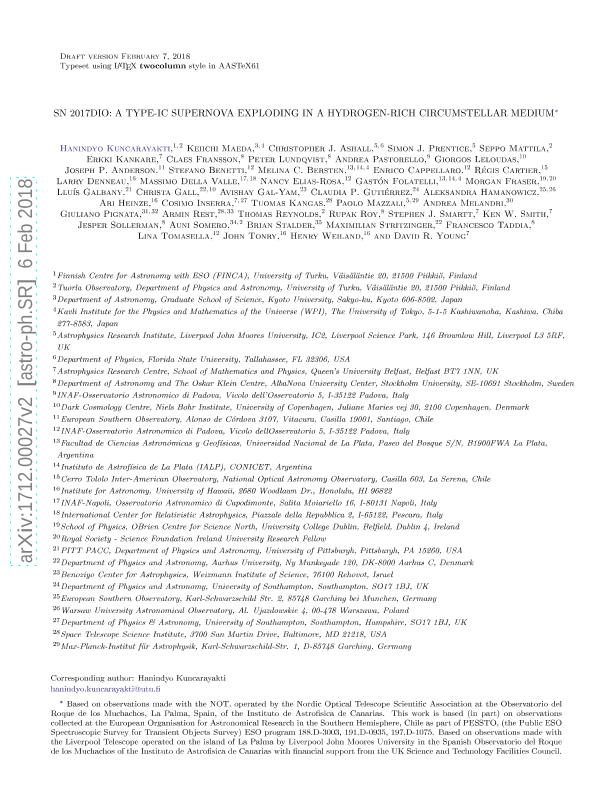Artículo
SN 2017dio: A Type-Ic Supernova Exploding in a Hydrogen-rich Circumstellar Medium
Kuncarayakti, Hanindyo; Maeda, Keiichi; Ashall, Christopher J.; Prentice, Simon J.; Mattila, Seppo; Kankare, Erkki; Fransson, Claes; Lundqvist, Peter; Pastorello, Andrea; Leloudas, Giorgos; Anderson, Joseph P.; Benetti, Stefano; Bersten, Melina Cecilia ; Cappellaro, Enrico; Cartier, Régis; Denneau, Larry; Della Valle, Massimo; Elias Rosa, Nancy; Folatelli, Gaston
; Cappellaro, Enrico; Cartier, Régis; Denneau, Larry; Della Valle, Massimo; Elias Rosa, Nancy; Folatelli, Gaston ; Fraser, Morgan; Galbany, Lluís; Gall, Christa; Gal-Yam, Avishay; Gutiérrez, Claudia P.; Hamanowicz, Aleksandra; Heinze, Ari; Inserra, Cosimo; Kangas, Tuomas; Mazzali, Paolo; Melandri, Andrea; Pignata, Giuliano; Rest, Armin; Reynolds, Thomas; Roy, Rupak; Smartt, Stephen J.; Smith, Ken W.; Sollerman, Jesper; Somero, Auni; Stalder, Brian; Stritzinger, Maximilian; Taddia, Francesco; Tomasella, Lina; Tonry, John; Weiland, Henry; Young, David R.
; Fraser, Morgan; Galbany, Lluís; Gall, Christa; Gal-Yam, Avishay; Gutiérrez, Claudia P.; Hamanowicz, Aleksandra; Heinze, Ari; Inserra, Cosimo; Kangas, Tuomas; Mazzali, Paolo; Melandri, Andrea; Pignata, Giuliano; Rest, Armin; Reynolds, Thomas; Roy, Rupak; Smartt, Stephen J.; Smith, Ken W.; Sollerman, Jesper; Somero, Auni; Stalder, Brian; Stritzinger, Maximilian; Taddia, Francesco; Tomasella, Lina; Tonry, John; Weiland, Henry; Young, David R.
 ; Cappellaro, Enrico; Cartier, Régis; Denneau, Larry; Della Valle, Massimo; Elias Rosa, Nancy; Folatelli, Gaston
; Cappellaro, Enrico; Cartier, Régis; Denneau, Larry; Della Valle, Massimo; Elias Rosa, Nancy; Folatelli, Gaston ; Fraser, Morgan; Galbany, Lluís; Gall, Christa; Gal-Yam, Avishay; Gutiérrez, Claudia P.; Hamanowicz, Aleksandra; Heinze, Ari; Inserra, Cosimo; Kangas, Tuomas; Mazzali, Paolo; Melandri, Andrea; Pignata, Giuliano; Rest, Armin; Reynolds, Thomas; Roy, Rupak; Smartt, Stephen J.; Smith, Ken W.; Sollerman, Jesper; Somero, Auni; Stalder, Brian; Stritzinger, Maximilian; Taddia, Francesco; Tomasella, Lina; Tonry, John; Weiland, Henry; Young, David R.
; Fraser, Morgan; Galbany, Lluís; Gall, Christa; Gal-Yam, Avishay; Gutiérrez, Claudia P.; Hamanowicz, Aleksandra; Heinze, Ari; Inserra, Cosimo; Kangas, Tuomas; Mazzali, Paolo; Melandri, Andrea; Pignata, Giuliano; Rest, Armin; Reynolds, Thomas; Roy, Rupak; Smartt, Stephen J.; Smith, Ken W.; Sollerman, Jesper; Somero, Auni; Stalder, Brian; Stritzinger, Maximilian; Taddia, Francesco; Tomasella, Lina; Tonry, John; Weiland, Henry; Young, David R.
Fecha de publicación:
02/2018
Editorial:
IOP Publishing
Revista:
Astrophysical Journal
ISSN:
2041-8205
Idioma:
Inglés
Tipo de recurso:
Artículo publicado
Clasificación temática:
Resumen
SN 2017dio shows both spectral characteristics of a type-Ic supernova (SN) and signs of a hydrogen-rich circumstellar medium (CSM). Prominent, narrow emission lines of H and He are superposed on the continuum. Subsequent evolution revealed that the SN ejecta are interacting with the CSM. The initial SN Ic identification was confirmed by removing the CSM interaction component from the spectrum and comparing with known SNe Ic and, reversely, adding a CSM interaction component to the spectra of known SNe Ic and comparing them to SN 2017dio. Excellent agreement was obtained with both procedures, reinforcing the SN Ic classification. The light curve constrains the pre-interaction SN Ic peak absolute magnitude to be around Mg = -17.6 mag. No evidence of significant extinction is found, ruling out a brighter luminosity required by an SN Ia classification. These pieces of evidence support the view that SN 2017dio is an SN Ic, and therefore the first firm case of an SN Ic with signatures of hydrogen-rich CSM in the early spectrum. The CSM is unlikely to have been shaped by steady-state stellar winds. The mass loss of the progenitor star must have been intense, M ∼ 0.02 ϵ Hα/0.01) -1 (v wind /500 km s -1 ) (v shock 10,000 km s-1 ) -3 Me yr -1 , peaking at a few decades before the SN. Such a high mass-loss rate might have been experienced by the progenitor through eruptions or binary stripping.
Palabras clave:
Supernovae: General
,
Supernovae: Individual (Sn 2017dio)
Archivos asociados
Licencia
Identificadores
Colecciones
Articulos(IALP)
Articulos de INST.DE ASTROFISICA LA PLATA
Articulos de INST.DE ASTROFISICA LA PLATA
Citación
Kuncarayakti, Hanindyo; Maeda, Keiichi; Ashall, Christopher J.; Prentice, Simon J.; Mattila, Seppo; et al.; SN 2017dio: A Type-Ic Supernova Exploding in a Hydrogen-rich Circumstellar Medium; IOP Publishing; Astrophysical Journal; 854; 1; 2-2018
Compartir
Altmétricas



